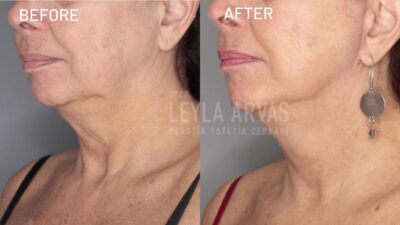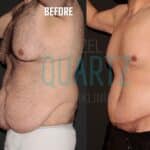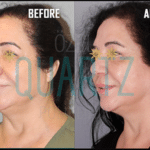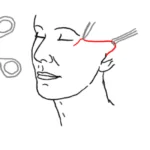Face lift surgery cover lifting procedures containing the upper, mid and lower parts of the face. Face lift surgery is mostly preferred the ages approximately between 35-65. This operation can be combined with upper and lower eyelid operation and fat transfer.
New face designed with a facelift surgery must create a natural and specific look. Results must be shared with the patient before the operation.
How is Face Lift Surgery Made?
Face lift surgery can be combined with the fat injection. Fat tissue taken from the patient’s own body is injected into desired areas. Ones who had face lift can also have forehead and eyebrow lift. This step is recommended to patients who have problems in the upper part of their faces. In this procedure that is realized endoscopically, incision is extended to the temporal side. Mid-face lift procedure is completed through the lower incision.
Types Of Face Lift Surgery
Facelift surgery is a popular cosmetic procedure that can help individuals achieve a more youthful and refreshed appearance. While the basic technique involves lifting and tightening sagging skin on the face and neck, there are several different types of facelift surgery that can be customized to meet the individual’s needs and concerns. In this article, we’ll explore the most common types of facelift surgery.
- Traditional Facelift
The traditional facelift, also known as a full facelift, is the most extensive type of facelift surgery. It involves making incisions around the hairline and ears, lifting the skin and underlying tissue, and removing any excess skin before suturing the incisions closed. The traditional facelift can address sagging skin on the cheeks, jawline, and neck, as well as deep wrinkles and creases around the mouth and nose.
- SMAS Facelift
SMAS (superficial musculo-aponeurotic system) facelift is a technique that involves lifting and tightening the underlying muscles and tissues of the face and neck. This technique can be used for both full and mini facelifts and provides longer-lasting results compared to other techniques. The incisions are made around the hairline and ear and the surgeon lifts and tightens the underlying tissue to create a more youthful appearance.
- Deep Plane Facelift
The deep plane facelift is a technique that focuses on lifting and tightening the deep layers of the face and neck. This technique is ideal for individuals who have significant sagging in the midface and neck. The incisions are made around the hairline and ear, and the surgeon lifts and repositions the deeper layers of tissue to create a more natural and youthful appearance.
- Endoscopic Facelift
The endoscopic facelift is a minimally invasive technique that uses a small camera to guide the surgeon in lifting and tightening the facial tissue. This technique involves making small incisions around the hairline and temples and using specialized instruments to lift and tighten the underlying tissue. The endoscopic facelift is ideal for individuals who have mild to moderate sagging and want a quicker recovery time compared to other techniques.
- Mini Facelift
The mini facelift, also known as a partial facelift or weekend facelift, is a less extensive version of the traditional facelift. It involves making smaller incisions around the hairline and ears, lifting the skin and tissue, and removing minimal amounts of excess skin. The mini facelift is ideal for individuals who have mild to moderate sagging in the lower face and neck.
- Mid Facelift
The mid facelift, also known as a cheek lift, focuses on lifting and tightening the skin and tissue in the middle of the face. It involves making incisions around the hairline and lower eyelids, lifting the skin and tissue, and repositioning it to create a more youthful contour. The mid facelift can address sagging cheeks, deep nasolabial folds, and under-eye bags.
- Thread Facelift
The thread facelift, also known as a non-surgical facelift, is a minimally invasive procedure that uses dissolvable threads to lift and tighten sagging skin. The threads are inserted under the skin using a needle and are then gently pulled to create a lift. The thread facelift is ideal for individuals who have mild to moderate sagging in the lower face and neck and want to avoid surgery.
- Liquid Facelift
The liquid facelift is a non-surgical procedure that uses injectable fillers and neurotoxins to restore volume and smooth out wrinkles and lines on the face. The procedure involves injecting fillers such as hyaluronic acid or collagen into areas of the face that have lost volume, and injecting neurotoxins such as Botox to relax muscles and smooth out wrinkles. The liquid facelift is ideal for individuals who have mild to moderate signs of ageing and want a non-surgical option.
 How is Full Face Lift Operation Made?
How is Full Face Lift Operation Made?
Full face lift operations start from the front of the ear and ends at its back. Full face lift operations are made by skin lifting with an incision from the back of the ear to the scalp. If the patient has no drooping in his/her neck, the scar is left by the ear, and this procedure can also be called face lift with a minimum scar.
This cosmetic operation is the procedure of suturing and lifting and shaping the beneath layer of skin that contains our mimic muscles, and it is very important for the patient not to regain its former facial form. If there is drooping or excess fat in the neck and double chin, fats are removed by the help of vaser liposuction. If the patient has wrinkles in his/her neck, the neck is opened with a short incision from the chin and neck muscles are sutured together. This procedure makes the angle of the neck prominent.
How Should the Patient get Prepared Before the Operation?
Person who wants to have operation should not take aspirin, smoke and consume alcohol for three weeks preceding the operation. It is recommended to avoid blood thinners within the last week before the operation.
Is Anesthesia Required for the Operation?
Face lift operation is made under general anesthesia in the hospital environment.
How Long Does a Face Lift Operation Take?
This operation generally takes 3-6 hours. If the person also needs eyelid lift, the operation can take 5-7 hours.
What Does the Patient Experience After the Face Lift Operation?
Face lift is not a painful operation. Patients generally complain about feeling of tension and burning, rather than pain. However, this feeling will disappear within a few days after the operation. Swellings to occur after the operation disturb the patient, but these complications are quite normal after the face lift. Patients are recommended to stay at the hospital for one night. One week later, bruises and swelling disappear to a high extent. Complete disappearance of bruises and swelling will take 20 days. However, it may take 3 months for the face to get fit and gain its final shape, depending on the procedures applied and thickness of patient’s skin. The patient should protect him/herself against direct sunlight for 3 months, as he/she should protect after all face operations.
Does Face Lift Bring Permanent Results?
After the operation, aging process continues so with the negative effect of aging loosening and drooping can be expected in lifted areas. However, the face never returns to its first state. Permanence of results varies depending on the person’s features and technique used by the physician. If the person has a thick and oily skin, drooping can be observed earlier. The operation consists of several procedures determined according to the patient’s needs. It is very important that the patient and surgeon understand each other well and discuss the procedures. Suturing is made in the manner that the scars are in front and back of the ear and in the scalp.
How long do face lifts last?
The longevity of a facelift varies from patient to patient, and is influenced by a number of factors, including the patient’s age, skin quality, and lifestyle habits.
In general, a facelift can be expected to last for around 10 years. However, this can vary depending on the patient’s individual circumstances. Patients who take good care of their skin and avoid excessive sun exposure may find that their facelift results last longer than 10 years, while those who smoke or engage in other unhealthy habits may find that their results fade more quickly.
It’s important to keep in mind that while a facelift can produce long-lasting results, it does not stop the aging process. Over time, the effects of aging will begin to show again and patients may consider additional procedures or treatments to maintain their youthful appearance.
What is the Difference Between a Face Lift Operation and Thread Lift?
Face lift operation is a surgical procedure bringing completely permanent results. With a surgical method, excess skin tissue is cut and the face is sutured tightly. Face lift operation is performed under general anesthesia.
Thread Lift is a medical application. It does not bring permanent results. Thread Lift is applied with tiny incisions. Thanks to threads placed underneath the skin, skin is lifted up. Because medical threads are used in this application, the result fits mimics. Face lift operation is recommended to those with higher level drooping. If you have slight drooping and fine wrinkles, you can consider having a thread lift procedure.
What Age is Best for Face Lift Surgery?
Facial rejuvenation operation is generally recommended in cases of high-level sagging. With a face lift operation, drooping face that cannot be treated with Botox or thread lift is rejuvenated permanently and effectively. Face lift is generally recommended to patients at the age after 35 and over. But if the patient’s sagging and wrinkles are more than normal, face lift operation can also be made before age 50. In case of need, medical skin rejuvenation application such as Botox may be used as well.
Generally speaking, there is no specific age that is considered the “best” for a facelift. Instead, the decision to undergo a facelift should be based on the individual’s unique needs and goals. Some individuals may choose to have a facelift in their 40s or 50s, while others may wait until they are in their 60s or 70s.
One of the main factors to consider when deciding on the best age for a facelift is the extent of the signs of aging. If you have mild to moderate signs of aging, such as fine lines and wrinkles, a non-surgical treatment like Botox or dermal fillers may be a better option. However, if you have more severe signs of aging, such as deep wrinkles, sagging skin, and jowls, a facelift may be the most effective solution.
Another factor to consider is your overall health and wellbeing. Facelift surgery is a major procedure that requires a general anaesthetic, so it’s important to be in good health before undergoing the surgery. This means being at a healthy weight, not smoking, and having no underlying medical conditions that could increase the risk of complications.
Lastly, it’s important to have realistic expectations about the results of a facelift. While the procedure can provide significant improvements to your appearance, it cannot completely stop the aging process. The results of a facelift typically last for several years, but they will eventually begin to fade as the natural aging process continues.
In conclusion, there is no one-size-fits-all answer to the best age for a facelift. The decision to undergo the procedure should be based on individual needs and goals, as well as overall health and wellbeing. It’s important to consult with a qualified and experienced plastic surgeon to determine whether facelift surgery is the right option for you.
Pros and Cons of Facelift Surgery
What is pros and cons of facelift surgery
Facelift surgery, like any medical procedure, has its pros and cons. Understanding these can help you make an informed decision about whether facelift surgery is the right option for you.
Pros:
- Improved appearance: Facelift surgery can provide a more youthful and refreshed appearance by reducing the visible signs of aging, such as sagging skin, jowls, and deep wrinkles.
- Increased self-confidence: Many people who undergo facelift surgery report feeling more confident and positive about their appearance, which can have a positive impact on their overall quality of life.
- Long-lasting results: While the results of facelift surgery are not permanent, they typically last for several years, which means you can enjoy a more youthful appearance for an extended period of time.
Cons:
- Surgery risks: As with any surgery, there are risks associated with facelift surgery, such as bleeding, infection, and adverse reactions to anesthesia.
- Recovery time: Facelift surgery requires a significant amount of downtime for recovery, which can range from several days to several weeks depending on the extent of the procedure.
- Cost: Facelift surgery can be expensive, and is generally not covered by insurance as it is considered a cosmetic procedure.
- Possible scarring: While plastic surgeons take great care to minimize scarring, some scarring is inevitable with facelift surgery. However, these scars are typically well-hidden and fade over time.
- Unrealistic expectations: It’s important to have realistic expectations about the results of facelift surgery. While it can provide significant improvements to your appearance, it cannot completely stop the aging process, and the results may not be as dramatic as you had hoped.
How is Face lift Surgery Scars?
Facelift scars are an inevitable part of the facelift surgery process. However, skilled plastic surgeons take great care to minimize scarring and ensure that scars are as inconspicuous as possible.
During a traditional facelift, incisions are typically made along the hairline and around the ears, which allows the plastic surgeon to lift and tighten the underlying tissues of the face. While these incisions are strategically placed to minimize scarring, some scarring is inevitable.
However, plastic surgeons use a variety of techniques to minimize scarring and ensure that scars are as inconspicuous as possible. These techniques may include:
- Placing incisions in inconspicuous locations, such as along the natural hairline or behind the ears.
- Using fine, dissolvable sutures to close incisions, which reduces the risk of visible scarring.
- Using techniques such as laser resurfacing or chemical peels to reduce the appearance of scars after surgery.
- Providing detailed post-operative instructions to ensure that scars heal properly and quickly.
It’s important to keep in mind that while some scarring is inevitable with facelift surgery, the scars are typically well-hidden and fade over time. Most patients find that the benefits of a facelift, including a more youthful and refreshed appearance, far outweigh the minor scarring that may result from the procedure.
If you’re concerned about the potential for scarring after a facelift, be sure to discuss your concerns with your plastic surgeon. They can provide detailed information on the surgical techniques they use to minimize scarring and help you make an informed decision about whether facelift surgery is right for you.
How is Recovery Process of Face Lift Surgery?
The recovery process for facelift surgery can vary from person to person, but there are some general guidelines that can give you an idea of what to expect on a daily basis.
Immediately after surgery, you will likely have bandages around your head and neck to minimize swelling and support the healing tissues. You may also have drainage tubes to help remove excess fluids from the surgical area.
In the first few days after surgery, you will need to rest and avoid any strenuous activity or bending over. You may experience some discomfort, swelling, and bruising, which can be managed with pain medication and ice packs.
By the end of the first week, most patients are able to return to light activities, such as walking or doing light household chores. You may still have some bruising and swelling, but this should gradually improve over the next few weeks.
During the second and third weeks after surgery, you should continue to avoid strenuous activity and follow your surgeon’s instructions for caring for the surgical area. You may also have follow-up appointments to monitor your healing progress and remove any stitches or drainage tubes.
By the end of the fourth week, most patients are able to resume normal activities, including exercise and work. However, you may still have some residual swelling and numbness, which can take several months to fully resolve.
Overall, the recovery process for facelift surgery can take several weeks to several months, depending on the individual and the extent of the surgery. It’s important to follow your surgeon’s instructions for care and recovery, and to be patient and gentle with your healing tissues to ensure the best possible results.
Can you have multiple face lifts?
Technically, there is no limit to the number of facelifts that a person can have. However, it’s important to keep in mind that facelift surgery is a major procedure that involves significant downtime and recovery, and multiple surgeries can increase the risks of complications.
Most plastic surgeons recommend waiting at least 10 years between facelifts to allow enough time for the skin and underlying tissues to heal and settle. Additionally, it’s important to have realistic expectations about the results of facelift surgery and understand that the effects are not permanent.
If you are considering multiple facelifts, it’s important to discuss your goals and concerns with a board-certified plastic surgeon who has experience performing these procedures. They can evaluate your individual needs and help you determine whether additional surgeries are appropriate for you, and if so, the best timing and approach to achieve your desired results while minimizing risks and complications.
How Much Does Face Lift Surgery Cost in Turkey?
The cost of facelift surgery in Turkey can vary depending on a range of factors, including the type of facelift, the surgeon’s experience and reputation, the location of the clinic, and the extent of the surgery required. On average, the cost of a facelift in Turkey can range from £2,500 to £6,000, which is significantly lower than the cost of the same procedure in many other countries.
Factors that Can Impact the Cost of Facelift Surgery in Turkey
- Type of Facelift: The type of facelift you choose can impact the cost of the procedure. For example, a full facelift will typically cost more than a mini facelift.
- Surgeon’s Experience and Reputation: The experience and reputation of the surgeon can also impact the cost of the procedure. Highly experienced and reputable surgeons may charge more for their services.
- Location of the Clinic: The location of the clinic can also affect the cost of the procedure. Clinics located in major cities or tourist areas may charge more than those in less populated areas.
- Extent of the Surgery Required: The extent of the surgery required can also impact the cost of the procedure. For example, if you require additional procedures such as a neck lift or brow lift, the cost will be higher.
For Turkish Ministry of Health-accredited centers, it is not legal to specify prices on their website. Therefore, please dial 0212 241 46 24 to contact our polyclinic and get information on our facial rejuvenation operation prices.
What procedures can be combined with a facelift?
Facelift surgery can be combined with a variety of other procedures to enhance the overall rejuvenation of the face. Some of the most common procedures that are combined with a facelift include:
- Eyelid surgery: Also known as blepharoplasty, this procedure can help to remove excess skin and fat from the upper and/or lower eyelids, creating a more refreshed and youthful appearance.
- Brow lift: A brow lift can help to lift and smooth out the forehead and brow area, reducing wrinkles and lines and creating a more alert and youthful appearance.
- Neck lift: A neck lift can address sagging skin and excess fat in the neck area, creating a more defined and youthful jawline and neck contour.
- Fat grafting: This procedure involves taking fat from one area of the body and transferring it to the face to restore volume and create a more youthful and natural appearance.
- Lip Lift: During a facelift, the plastic surgeon will typically focus on addressing sagging skin and muscles in the lower face and neck. However, combining a lip lift with a facelift can provide additional benefits, such as improving the appearance of the mouth area and creating a more harmonious balance between the upper and lower face.
- Skin resurfacing: Procedures such as chemical peels, laser resurfacing, and dermabrasion can help to improve skin texture, reduce wrinkles and lines, and create a more youthful and radiant complexion.
The combination of procedures that is right for you will depend on your individual needs and goals, as well as your overall health and medical history. It’s important to discuss your options with a board-certified plastic surgeon who has experience performing these procedures, and to have realistic expectations about the results and recovery process.













